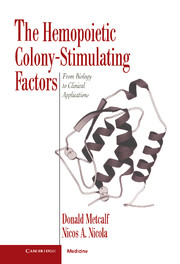Book contents
- Frontmatter
- Contents
- Preface
- 1 Historical introduction
- 2 General introduction to hemopoiesis
- 3 Key techniques in analyzing hemopoiesis
- 4 Biochemistry of the colony-stimulating factors
- 5 Biochemistry of the colony-stimulating factor receptors
- 6 Molecular genetics of the colony-stimulating factors and their receptors
- 7 Biological actions of the colony-stimulating factors in vitro
- 8 The biology of colony-stimulating factor production, degradation, and clearance
- 9 Actions of the colony-stimulating factors in vivo
- 10 Role of the colony-stimulating factors in basal hemopoiesis
- 11 Actions of the colony-stimulating factors in resistance to infections
- 12 Role of the colony-stimulating factors in other disease states
- 13 The colony-stimulating factors and myeloid leukemia
- 14 Clinical uses of the colony-stimulating factors
- 15 Conclusions
- References
- Index
11 - Actions of the colony-stimulating factors in resistance to infections
Published online by Cambridge University Press: 04 August 2010
- Frontmatter
- Contents
- Preface
- 1 Historical introduction
- 2 General introduction to hemopoiesis
- 3 Key techniques in analyzing hemopoiesis
- 4 Biochemistry of the colony-stimulating factors
- 5 Biochemistry of the colony-stimulating factor receptors
- 6 Molecular genetics of the colony-stimulating factors and their receptors
- 7 Biological actions of the colony-stimulating factors in vitro
- 8 The biology of colony-stimulating factor production, degradation, and clearance
- 9 Actions of the colony-stimulating factors in vivo
- 10 Role of the colony-stimulating factors in basal hemopoiesis
- 11 Actions of the colony-stimulating factors in resistance to infections
- 12 Role of the colony-stimulating factors in other disease states
- 13 The colony-stimulating factors and myeloid leukemia
- 14 Clinical uses of the colony-stimulating factors
- 15 Conclusions
- References
- Index
Summary
The principal clinical interest in the colony-stimulating factors is based on the general proposition that because leukopenia is well recognized to be associated with enhanced susceptibility to infections (Bodey et al., 1966), the use of CSFs to increase white cell levels and/or function might result in increased resistance to infections.
Evidence was reviewed in Chapter 8 that serum CSF levels are often elevated during acute infections and that the local production of CSF can increase greatly after a local tissue infection. Nevertheless, the serum levels do not approach those produced by injecting CSF, and the possible capacity of injected CSF to enhance resistance to infections is an important question that warrants experimental and clinical investigation.
To investigate the possible value of CSF administration to experimental models that duplicate to some degree the common clinical situations in which leukopenia is present requires pretreatment of the animals in order to damage bone marrow cells or to lower their resistance to infections. A number of studies have revealed the enhancing effects of CSF injections on resistance to infections in models based on these considerations.
Matsumoto et al. (1987) showed that if mice were pretreated with cyclophosphamide, they became highly susceptible to death following challenge injection of organisms such as Pseudomonas, Staphylococcus aureus, or Candida albicans. The preinjection of cyclophosphamide-treated mice with G-CSF before challenge with microorganisms led to a thousandfold increase in their resistance to challenge infections (Figure 11.1).
- Type
- Chapter
- Information
- The Hemopoietic Colony-stimulating FactorsFrom Biology to Clinical Applications, pp. 211 - 214Publisher: Cambridge University PressPrint publication year: 1995



